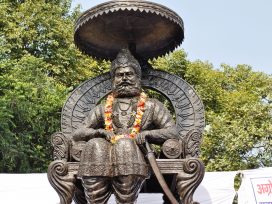An experiment was carried out at CBS Pune to evaluate the Bio energy Field of AgraBhagwat with Poly-contrast Interference Photography
Introduction
Poly-contrast Interference Photography (PIP): PIP is a light analysis technology that requires the human body to be exposed to a full spectrum lighting environment. The patterns of absorption or reflection of light from the body are then analyzed. Typically it is understood that body will absorb more light (i.e. reflect less) in problem areas, in comparison to the rest of the participant’s body. The PIP software measures the absorption and reflection of light on the skin’s surface and surroundings then displays a composite image of the accentuated interference gradations on the screen. For this study the PIP scan were used to help identify congested areas of red as low energy and green and blue as positive energy.
Standard PIP pal will assess the bio field. Black and White filter is used to highlight energy particulate matter and is useful to note changes in before and after scans. Blend 2 is useful for detection of background values and for high contrast frames. Monet is a filter that shows channels of energy distribution or meridians. The significance of colors in filters differs from the standard PIP pal.
When we look at our human subject through our PIP system, all these things have to be taken into consideration. When it comes to the lighting, the angle of incidence has to be taken into account not to cast deep shadows on or from the subject. Very few problems however occur in practice, as long as the lighting parameters are kept constant, i.e. intensity, angles etc.
The light intensity can also be monitored with a photographic light meter. The ambient light and incident light values if recorded at regular intervals can be compared to and reproduced in other locations. This value is in either E.V. or Lux. Fluorescent full spectrum lights do fall off in intensity before they stop functioning, so they should be checked periodically to ensure that they are working correctly. Please take into account outside window light which is variable.
So when we look at a subject, we do not see that person at all, but the light reflected off that person. The photons carry that information to our eyes. These photons are focused on the back of our light sensitive film-like retinas and this is processed into electrical signals which pass along the back of the eye to the optic nerve. These in turn pass along the optical cortex at the back of our heads where the inverted (upside-down) image is interpreted the correct side up. All of that takes place every day of our lives from when we first open our eyes!
So the original photons, striking our person has passed through their energy field twice, once on the way in, the attack rays, and once on the way out, the reflected rays. These photon interference patterns are detected and interpreted by our camera interface and software. These patterns and vivid colors are seen on the viewing box as a real moving image, captures can then be made of these images in various file formats, either in raw data files or compressed image files. These images then go on to be viewed and interpreted.
Methodology
- The camera was set on a certain focus and then it was kept constant throughout the study.
- PIP scans were taken on following steps:
- Back drop scan was taken with 4 PIP filters- Zip pal, Black/White, Blend 2 & Monet.
- The afters scan were taken be after keeping the Aagra Bhagwat with all above mentioned filters.





- PIP pal image of the backdrop has shown a predominance of yellow with few interspersed frequencies of green and violet.
- PIP pal images of AgraBhagwat pages have shown significant increase in frequencies of green. The density of green has also increased.
- The field has become brighter and vibrant.
- A subtle combination green and blue is seen.
- Green is associated with healing and blue are calming vibrations.
- Violet is associated with higher cosmic vibrations.
- Similar results can be seen in the different filters used.
- Black and white shows increase in green and grey particulate matter of energy.
- The density of black has also increased. Blend 2 has shown increase in density of red and surrounding wine red glow.
- Monet has shown significant reduction in low orange and increase in density of higher cosmic vibrations in the form of violet.
- Significant increase in density of healing green can be seen in the scans of AgraBhagwat pages.
- It is interesting to note that green is not seen in the Monet backdrop.
Wet Pages
Backdrop






A comparison between the energy fields of the backdrop and wet pages has shown results that are same as the above experiment. The results are seen consistently in all the filters.
Conclusion
From the above study it can be concluded that Agrabhagwat pages have qualitatively positive energy field as compared to the baseline white wall backdrop. The results seen are the same for both dry and wet pages. There is minimal difference between the energy fields of the five pages. Since the chronology and the names of individual pages is not known, a cross comparison between these individual pages has not been done.
The Centre for Bio field Sciences
WPC MIT College, Paud road, Kothrud, Pune-411 038
PH: +91 20 2545 8748 Website: www.biofieldsciences.com






